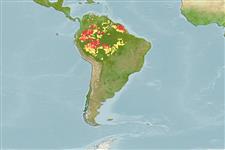Classification / Names
Common names | Synonyms | Catalog of Fishes (gen., sp.) | ITIS | CoL | WoRMS | Cloffa
Actinopterygii (ray-finned fishes) >
Siluriformes (Catfish) >
Heptapteridae (Three-barbeled catfishes)
Etymology: Chasmocranus: Greek, chanos, -eos, ous, and chasma, -atos = abyss, mouth opened, inmensity + Greek, kranion = skull (Ref. 45335). More on author: Eigenmann.
Environment / Climate / Range
Ecology
Freshwater; demersal. Tropical, preferred ?
South America: Coastal drainages from Guyana to Suriname, Negro, Orinoco and Xingu River basins.
Size / Weight / Age
Maturity: Lm ? range ? - ? cm
Max length : 17.0 cm SL male/unsexed; (Ref. 36914)
Captured in creeks with rocky bottoms and in areas where the water changes level (Ref. 27188). Lies hidden under rocks and Podostemaceae. Its color pattern, like that of the other Heptapterus, provides perfect camouflage. The species which occur more frequently with it are: Imparfinis minutus, Moenkhausia oligolepis, Pyrrhulina filamentosa, Characidium fasciadorsale [= Characidium zebra] and Crenicichla albopunctata (Ref. 35381).
Life cycle and mating behavior
Maturity | Reproduction | Spawning | Eggs | Fecundity | Larvae
Bockmann, F.A. and G.M. Guazzelli, 2003. Heptapteridae (Heptapterids). p. 406-431. In R.E. Reis, S.O. Kullander and C.J. Ferraris, Jr. (eds.) Checklist of the Freshwater Fishes of South and Central America. Porto Alegre: EDIPUCRS, Brasil. (Ref. 36914)
IUCN Red List Status (Ref. 115185)
CITES (Ref. 94142)
Not Evaluated
Threat to humans
Harmless
Human uses
More information
Common namesSynonymsMetabolismPredatorsEcotoxicologyReproductionMaturitySpawningFecundityEggsEgg development
ReferencesAquacultureAquaculture profileStrainsGeneticsAllele frequenciesHeritabilityDiseasesProcessingMass conversion
Tools
Special reports
Download XML
Internet sources
